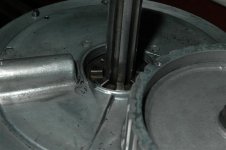Lakeside53
Stainless
- Joined
- Sep 28, 2007
- Location
- Woodinville, WA
My timing belt moves up when rotating one way and down when the other. When down it touches the cover and has worn a groove, and has been doing this for sometime before I bought it. I assume something isn't quite vertical and causes the belt to track , but why this changes with motor direction has me confused. The belts sheds on the bottom edge a little, is rubbing on the cover top, and that's not right. The pulley hub has a tiny amount of movement when located inside the top housing.

So.. I suspected the pulley...
The pulley bearings were shot. I replaced them with two Nachi 6207 C3 from H&W. The original bearings were factory ground for DB mounting and had identical length spacers. The new bearings of course have no preload and when clamped together, there's about 7-8 thou movement vertically, and a noticeable amount of movement laterally at the pulley.
I don't like that... So it opens up another can of worms...
I turned the outer spacer ring down so it was 8 thou (bearing movement) + 2 thou (a guesstimate for some preload) less than the inner ring. Bit of a pain to set up accurately in the lathe, but it came out o.k. Reassembly proved there was now no play. Powered it all up and the belt still tracks the same, but... noise (rattle) from the dog clutch is a lot less.
Preloading the bearings as I did, what should I be using as a net differential? If my 2 thou net preload is accurate, and the bearing doesn't get more than "warm" after 25 minutes at high speed, does this sound o.k.?
Others replace pulley bearings with non-DU types... do you put up with the sloppiness or do you attempt to preload them with shims or whatever?
So.. I suspected the pulley...
The pulley bearings were shot. I replaced them with two Nachi 6207 C3 from H&W. The original bearings were factory ground for DB mounting and had identical length spacers. The new bearings of course have no preload and when clamped together, there's about 7-8 thou movement vertically, and a noticeable amount of movement laterally at the pulley.
I don't like that... So it opens up another can of worms...
I turned the outer spacer ring down so it was 8 thou (bearing movement) + 2 thou (a guesstimate for some preload) less than the inner ring. Bit of a pain to set up accurately in the lathe, but it came out o.k. Reassembly proved there was now no play. Powered it all up and the belt still tracks the same, but... noise (rattle) from the dog clutch is a lot less.
Preloading the bearings as I did, what should I be using as a net differential? If my 2 thou net preload is accurate, and the bearing doesn't get more than "warm" after 25 minutes at high speed, does this sound o.k.?
Others replace pulley bearings with non-DU types... do you put up with the sloppiness or do you attempt to preload them with shims or whatever?



 A company I contacted wanted $5,000.00, to rebuild the severely worn spindle shaft, and no where to get new brass tapered bearings. Heck, I can buy a new 1400 lb surface grinder for a lot less than that!
A company I contacted wanted $5,000.00, to rebuild the severely worn spindle shaft, and no where to get new brass tapered bearings. Heck, I can buy a new 1400 lb surface grinder for a lot less than that! I buy my bearings from
I buy my bearings from 


